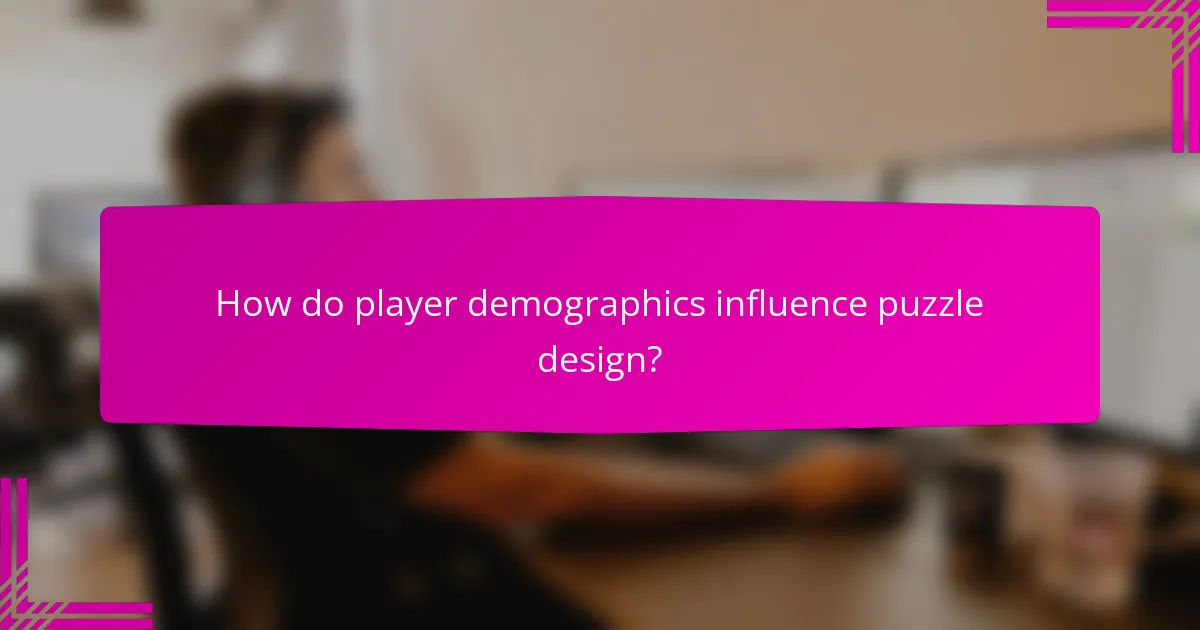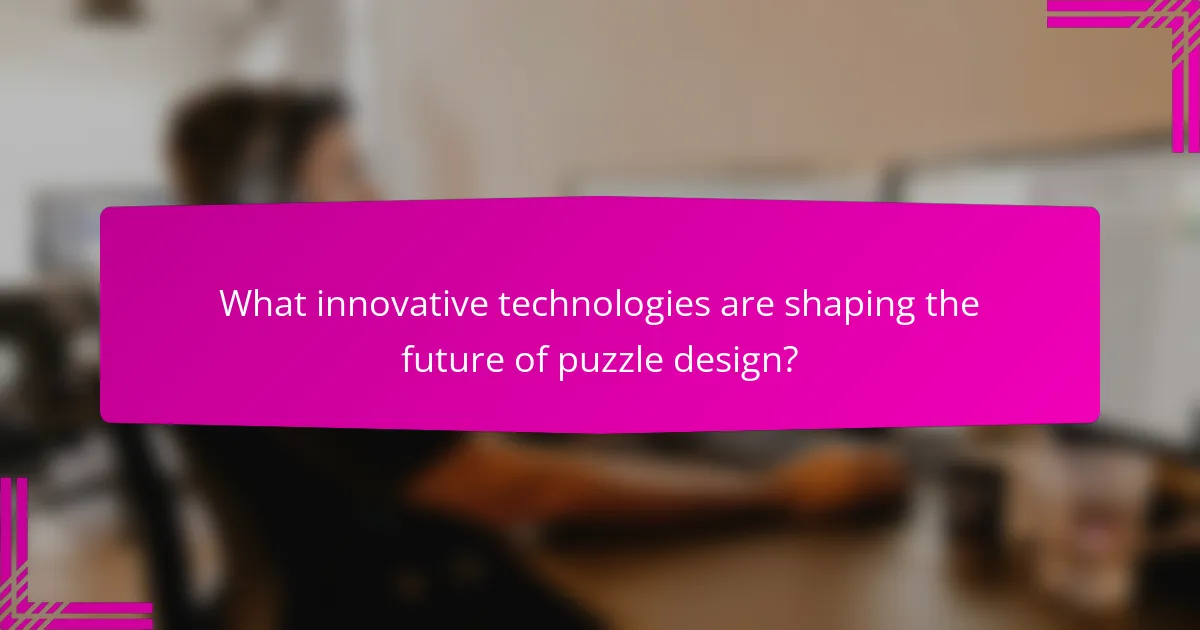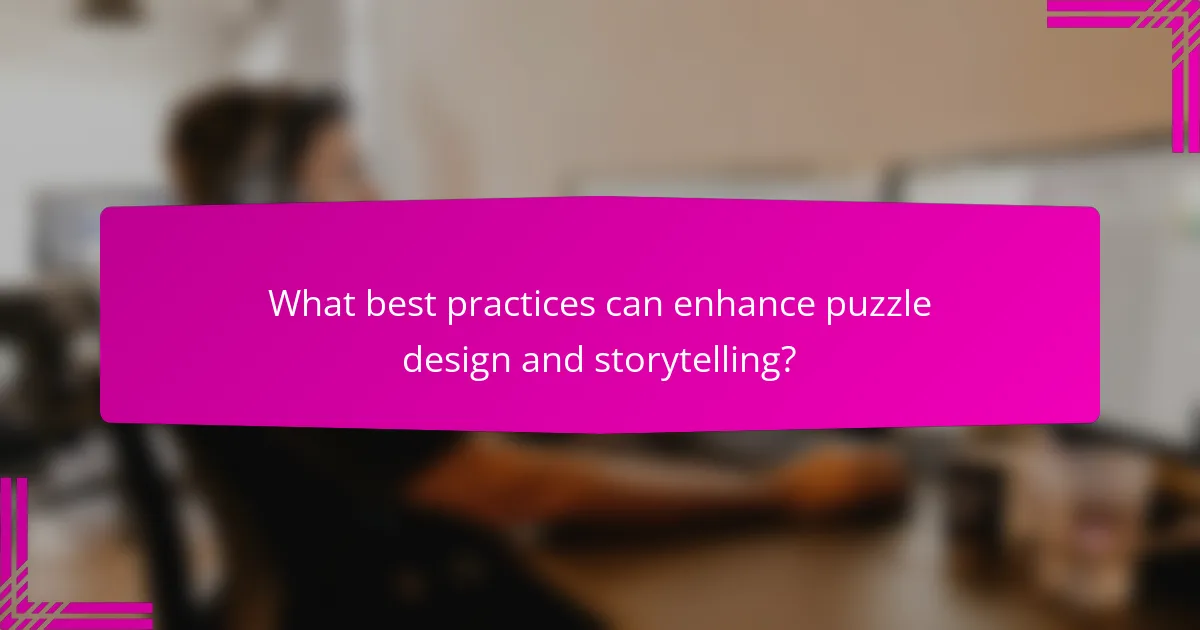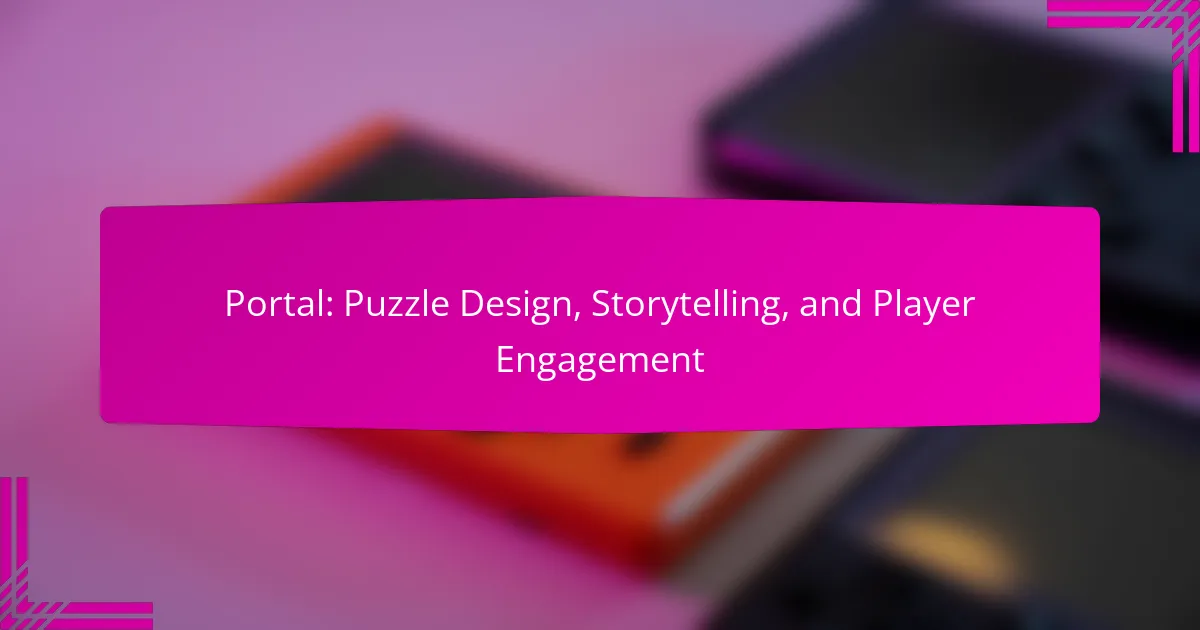Effective puzzle design and storytelling significantly enhance player engagement in games like Portal. This article explores how immersive challenges stimulate critical thinking, the role of narrative in driving gameplay dynamics, the influence of player demographics on puzzle design, and the importance of balancing difficulty for satisfaction. Additionally, it examines the impact of user feedback and innovative technologies on creating engaging experiences.

How does puzzle design enhance player engagement?
Puzzle design significantly enhances player engagement by creating immersive challenges that stimulate critical thinking and problem-solving skills. Engaging puzzles provide a sense of accomplishment, motivating players to progress through the game. Additionally, well-integrated puzzles often reveal narrative elements, deepening the emotional connection to the story. The unique mechanics of puzzle design in “Portal” encourage exploration and experimentation, fostering a rewarding gameplay experience. As players navigate these challenges, they develop a sense of agency, which is crucial for sustained engagement.
What are the key elements of effective puzzle design?
Effective puzzle design integrates clarity, challenge, and narrative to enhance player engagement. Key elements include:
1. **Clear Objectives**: Players must understand goals without confusion.
2. **Balanced Difficulty**: Puzzles should be challenging yet solvable, ensuring players feel accomplished.
3. **Logical Progression**: Solutions should follow a logical flow, guiding players through the experience.
4. **Engaging Storytelling**: Integrating narrative elements can deepen immersion and motivation.
5. **Feedback Mechanisms**: Providing immediate feedback helps players adjust strategies and enhances satisfaction.
Which psychological principles influence puzzle-solving?
Psychological principles influencing puzzle-solving include cognitive load, problem-solving strategies, and motivation. Cognitive load theory suggests that excessive information can hinder performance. Effective problem-solving strategies, such as breaking down tasks, enhance engagement. Motivation, driven by intrinsic rewards, encourages players to persist in challenges. These principles create a compelling experience in puzzle design, enhancing storytelling and player engagement.
How do different genres utilize puzzles for engagement?
Different genres utilize puzzles to enhance player engagement by integrating them into gameplay and storytelling. For instance, adventure games often use environmental puzzles to deepen narrative immersion. Puzzle-platformers emphasize spatial reasoning, challenging players to navigate levels creatively. Role-playing games incorporate puzzles that unlock story elements, fostering exploration and discovery. Each genre tailors puzzle design to its mechanics, ensuring that challenges align with player expectations and enhance overall experience.

What role does storytelling play in puzzle games?
Storytelling enhances player engagement in puzzle games like Portal by creating an immersive narrative. This connection motivates players to solve challenges, as they become invested in the story and characters. The integration of puzzles with narrative elements fosters a deeper emotional response, encouraging exploration and problem-solving. Unique attributes, such as the character GLaDOS, exemplify how storytelling can drive gameplay dynamics, making the experience memorable and impactful.
How can narrative structure enhance puzzle gameplay?
Narrative structure enhances puzzle gameplay by integrating storytelling with mechanics, creating a cohesive experience. In “Portal,” the narrative drives player motivation, making puzzles feel purposeful. The unfolding story and character interactions deepen engagement, encouraging exploration and problem-solving. This synergy between narrative and gameplay fosters a more immersive environment, leading to a memorable player journey.
What are the common storytelling techniques used in puzzle design?
Common storytelling techniques in puzzle design include environmental storytelling, character-driven narratives, and player choice integration. These techniques enhance player engagement by creating immersive experiences. Environmental storytelling uses the game world to convey a narrative through visual cues and context. Character-driven narratives focus on character development, allowing players to connect emotionally. Player choice integration empowers players to influence the story, making their decisions impactful and personal. Each technique contributes to a cohesive and engaging puzzle experience, reinforcing the central theme of player involvement and narrative depth.
Which examples showcase successful integration of story and puzzles?
Portal effectively integrates storytelling and puzzles through its unique mechanics and narrative depth. The game uses environmental storytelling, where the setting and elements reveal backstory, enhancing player engagement.
For example, the use of the Companion Cube symbolizes emotional connection and sacrifice, blending puzzle-solving with narrative themes. The dialogue from GLaDOS, the AI, provides context and humor, making challenges more memorable.
Additionally, the game’s puzzles often reflect the narrative arc, such as the final escape representing freedom from control. This cohesion between story and gameplay fosters a deeper connection, ensuring players remain invested in both the puzzles and the overarching narrative.

How do player demographics influence puzzle design?
Player demographics significantly influence puzzle design by shaping difficulty, themes, and engagement strategies. Designers consider age, skill level, and cultural background to create appealing experiences. For example, younger players may prefer fast-paced puzzles, while older players might enjoy more narrative-driven challenges. Additionally, cultural factors can dictate the types of puzzles that resonate with different groups, affecting overall player satisfaction. Understanding these demographics allows for tailored gameplay that enhances player engagement and retention.
What are the preferences of casual vs. hardcore players?
Casual players prefer accessible gameplay and light storytelling, while hardcore players seek complex puzzles and deeper narratives. Casual players enjoy quick sessions, often favoring immediate gratification. In contrast, hardcore players invest time to master intricate mechanics and appreciate nuanced story elements.
Casual players typically engage with simpler puzzle designs that offer instant rewards. Hardcore players, however, thrive on challenging levels that require strategic thinking and problem-solving skills. The differences in player engagement stem from their varying preferences for depth, challenge, and narrative complexity.
How does cultural background affect puzzle-solving approaches?
Cultural background significantly influences puzzle-solving approaches by shaping cognitive styles and problem-solving strategies. Different cultures emphasize various values, such as collectivism or individualism, which can affect how players engage with puzzles in games like Portal.
For instance, players from collectivist cultures may prefer collaborative problem-solving, while those from individualistic cultures might focus on independent solutions. This variation can lead to distinct gameplay experiences, as cultural norms dictate the preferred methods for overcoming challenges.
Moreover, cultural narratives and storytelling techniques impact how players interpret puzzles. Familiarity with certain themes or symbols can enhance engagement and comprehension, allowing players to connect with the game’s story on a deeper level.
In summary, cultural background not only informs the methods players use to solve puzzles but also enriches their overall gaming experience through diverse perspectives and interpretations.
What demographic trends are emerging in puzzle gaming?
Puzzle gaming is increasingly appealing to diverse demographics, particularly younger players and women. The rise of mobile platforms has attracted casual gamers, expanding the audience. Additionally, narrative-driven puzzles engage players seeking immersive experiences. Unique attributes like community-driven content and social features enhance player engagement, fostering collaboration and competition.

What are the challenges in balancing difficulty and player satisfaction?
Balancing difficulty and player satisfaction involves creating challenges that engage players without causing frustration. Key challenges include misjudging player skill levels, which can lead to either excessive difficulty or lack of challenge. Another issue is ensuring that puzzles are intuitive yet complex enough to maintain interest. Effective feedback mechanisms are crucial; without timely guidance, players may feel lost. Additionally, narrative integration must align with gameplay to enhance immersion and satisfaction.
How can designers assess puzzle difficulty effectively?
Designers can assess puzzle difficulty effectively by utilizing player feedback, testing various skill levels, and analyzing completion times. These methods provide insights into player engagement and challenge perception. Incorporating metrics like error rates and time spent on puzzles helps refine difficulty levels. Evaluating player interactions with puzzle elements reveals unique attributes influencing their experience.
What strategies can be employed to maintain player interest?
To maintain player interest, developers can implement engaging mechanics and narrative elements. Incorporating puzzles that evolve in complexity keeps players challenged. A compelling storyline enhances emotional investment, while regular updates introduce fresh content. Feedback loops and rewards sustain motivation, encouraging continued play.
Which common pitfalls should be avoided in puzzle design?
To avoid common pitfalls in puzzle design, focus on clarity, balance, and player feedback.
Ambiguous puzzles frustrate players, so ensure instructions and objectives are clear. Overly complex designs can overwhelm, so maintain a balance between challenge and accessibility. Additionally, neglecting player feedback can lead to misalignment with player expectations, diminishing engagement and enjoyment.
Incorporating these principles enhances the overall player experience and fosters deeper engagement with the game.

How can user feedback shape puzzle design improvements?
User feedback can significantly enhance puzzle design by identifying player frustrations and preferences. This input allows designers to refine difficulty levels, mechanics, and narrative integration. For example, player insights can lead to clearer instructions or more engaging story elements, ultimately improving overall engagement and satisfaction. Incorporating feedback fosters a sense of community and investment among players, making them feel valued in the design process.
What methods are effective for collecting player feedback?
Effective methods for collecting player feedback include surveys, focus groups, in-game analytics, and community forums. These approaches provide valuable insights into player experiences and preferences.
Surveys can be distributed post-game or via email, allowing players to share their thoughts on gameplay and story elements. Focus groups enable direct interaction with selected players, fostering in-depth discussions about their experiences. In-game analytics track player behavior, revealing patterns that inform design decisions. Community forums create a space for ongoing dialogue, where players can voice opinions and suggest improvements.
Combining these methods enhances understanding of player engagement and satisfaction, ultimately improving game design.
How can iterative design enhance puzzle quality?
Iterative design significantly enhances puzzle quality by refining gameplay through continuous feedback. This approach allows designers to identify player frustrations and adjust challenges accordingly. Testing various iterations helps balance difficulty and engagement, ensuring puzzles remain stimulating yet solvable. Furthermore, integrating player feedback fosters a deeper connection to the narrative, enhancing overall storytelling. Ultimately, iterative design leads to a more polished and enjoyable gaming experience.
What role does community engagement play in puzzle development?
Community engagement is crucial in puzzle development as it enhances creativity and player connection. Engaging with a community provides valuable feedback, inspiring innovative puzzle designs that resonate with players. This collaboration fosters a sense of ownership among players, motivating them to participate actively in the game’s evolution. Additionally, community insights can lead to unique attributes in puzzles, ensuring they remain diverse and challenging. By incorporating player suggestions, developers can create a richer storytelling experience that aligns with the interests and preferences of the audience.

What innovative technologies are shaping the future of puzzle design?
Innovative technologies like augmented reality, artificial intelligence, and procedural generation are transforming puzzle design. These advancements enhance storytelling and player engagement, creating immersive experiences.
Augmented reality integrates real-world elements into puzzles, allowing players to interact with their environment. Artificial intelligence personalizes challenges based on player behavior, ensuring unique gameplay experiences. Procedural generation creates endless puzzle variations, enhancing replayability and engagement.
These technologies not only redefine puzzle mechanics but also deepen emotional connections through narrative integration. As a result, players experience richer stories and more engaging gameplay.
How are augmented reality and virtual reality changing player experiences?
Augmented reality and virtual reality enhance player experiences by immersing them in interactive environments. These technologies transform gameplay through engaging puzzle design and storytelling.
AR overlays digital elements onto the real world, allowing players to interact with their surroundings in novel ways. VR creates fully immersive worlds, enabling deeper emotional connections to narratives.
Both technologies increase player engagement by offering unique challenges and experiences. They encourage exploration and problem-solving, making gameplay more dynamic and stimulating.
As a result, players enjoy richer, more personalized experiences that foster creativity and collaboration. This evolution in gaming continues to redefine how stories are told and puzzles are solved.
Which tools are becoming essential for modern puzzle creators?
Modern puzzle creators find essential tools in game design software, narrative engines, and player analytics platforms. These tools enhance creativity, streamline development, and improve player engagement.
Game design software like Unity and Unreal Engine allows for intricate puzzle mechanics and immersive environments. Narrative engines such as Twine and Ink facilitate storytelling, helping creators weave compelling narratives into puzzles. Player analytics platforms like Google Analytics and PlaytestCloud provide insights on player behavior, informing adjustments to enhance user experience.
Additionally, collaboration tools like Trello and Slack streamline communication among team members, ensuring efficient project management. These tools collectively support the dynamic nature of puzzle design, fostering innovation and engagement.
What trends in AI are influencing puzzle design?
AI trends are reshaping puzzle design by enhancing interactivity, personalization, and narrative depth. Advanced algorithms analyze player behavior, creating tailored experiences that adapt to individual skill levels. Machine learning enables dynamic puzzle generation, offering unique challenges. AI-driven storytelling integrates seamlessly, enriching player engagement through immersive narratives.

What best practices can enhance puzzle design and storytelling?
Effective puzzle design and storytelling in “Portal” can enhance player engagement. Focus on integrating narrative elements with gameplay mechanics to create a cohesive experience.
1. Establish a strong narrative foundation that complements puzzles.
2. Use environmental storytelling to convey background and context.
3. Design puzzles that reflect character development and plot progression.
4. Provide feedback through narrative elements to guide players.
5. Encourage exploration and curiosity through layered storytelling.
6. Balance challenge and accessibility to maintain player interest.
How can designers create a seamless experience between puzzles and narrative?
Designers can create a seamless experience between puzzles and narrative by integrating story elements directly into gameplay mechanics. This approach enhances player engagement and fosters emotional connections.
Puzzles should reflect the narrative’s themes, ensuring that each challenge feels relevant to the story. For instance, a puzzle may require players to solve a mystery that ties into character development, making the gameplay more immersive.
Additionally, environmental storytelling can enhance puzzle design. Designers can embed clues within the game world, encouraging exploration and reinforcing the narrative context. This technique allows players to uncover the story organically while engaging with puzzles.
Finally, feedback mechanisms are essential. Providing players with narrative-driven responses to their puzzle-solving efforts can deepen their investment in the story and characters, creating a cohesive experience that blends gameplay and narrative seamlessly.
What are the most common mistakes in puzzle design to avoid?
Common mistakes in puzzle design include lack of clarity, overly complex mechanics, insufficient playtesting, and neglecting player feedback. Each mistake can hinder player engagement and disrupt storytelling.
1. Lack of Clarity: Puzzles should have clear objectives and instructions to prevent player frustration.
2. Overly Complex Mechanics: Complicated systems can alienate players; simplicity often enhances enjoyment.
3. Insufficient Playtesting: Testing with diverse players helps identify issues and improve the design.
4. Neglecting Player Feedback: Ignoring suggestions can lead to repetitive mistakes and disengagement.
Which resources can help aspiring designers improve their skills?
Aspiring designers can enhance their skills through various resources focused on puzzle design, storytelling, and player engagement. Online courses, such as those offered by platforms like Coursera and Udemy, provide structured learning on game design principles. Books like “The Art of Game Design” by Jesse Schell offer in-depth insights into creating engaging experiences. Participating in design communities, such as forums or social media groups, allows for networking and feedback. Additionally, analyzing successful games can reveal effective strategies in design and engagement.
